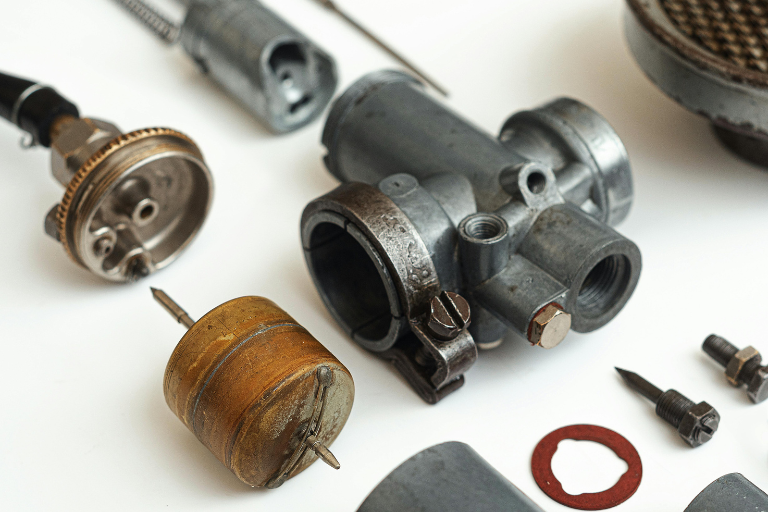Unlock the secret to a smoothly running lawn mower! Our simple step-by step guide teaches you how to efficiently unclog a lawn mower carburetor with a few simple steps.
Also, maximize your mower’s efficiency with continues reading on our step-by-step instructions on how to clean a carburetor for smoother operation.

Image credit: Magic K/Pexels
Tools Needed
- Adjustable wrench set
- Various sizes of screwdrivers
- Pliers
- Sturdy wire brush
- Carburetor cleaner
- Mild cleaning solvent (e.g., warm soapy water)
- Gloves
- Safety goggles
Materials Needed
- Carburetor cleaner
- Extra fuel line
Step-by-Step Guide (7)
1. Preparation and Safety
When you’re about to unclog a lawn mower carburetor, you’ll need to always ensure that your mower’s oil levels are safe. This can easily be checked by simply removing the dipstick from the oil tank and wiping it clean.
After reinserting it in the tank and pulling it back out again, you should be able to clearly see if your oil level is within the marked parameters on the dipstick. If not, make sure to fill up accordingly.
Pro tip: When preparing for this task also take note of other important parts such as spark plugs and fuel line. It’s recommended to disconnect these components before working on your machine for safety reasons.
Next up is brushing off any grass clippings stuck on different sections of the mower – especially around the carburetor area. Also, take out those clogged-up air filters which could be adding unnecessary strain on your engine. If it appears particularly dirty or clogged, consider getting a new one as this can lead to numerous maintenance issues including a dirty carb.
2. Accessing the Carburetor
To access the carburetor, you’ll first need to locate it. Most often, it will be located near the fuel line and air filter of your lawn mower. It’s usually in plain sight, but if you’re having trouble finding it, consult your owner’s manual or look up a diagram for your specific model online. Firstly, remove the air filter to gain better access.
The next step is to locate the fuel line and disconnect it carefully from the carburetor. Remember that there might be some residual gas in there so make sure to not accidentally spill any.
3. Disassembling the Carburetor
Once you’ve accessed the carburetor, you’ll see a fuel line running into it.
Pro tip: You don’t want to flood your workspace with gasoline. Therefore, make sure to pinch off the fuel line leading into the carburetor to prevent any leakage during your operation.
Once you’ve ensured all is safe and secure, start by removing this particular fuel line. Keep an old rag handy for any excess gas that might spill out. Be careful not to pull too hard and damage any vital parts of your lawn mower engine.
Next up are the bolts or screws holding everything together. Removing these will allow you access inside the beastly machine where all its guts live.
4. Unclogging the Carburetor
When you want to unclog a lawn mower carburetor you want to get yourself some carburetor cleaner. This stuff works wonders on gunked-up mower parts. Just make sure you’re working in a well-ventilated area when using it because the fumes can be pretty strong. You can use a toothbrush or paintbrush to apply the cleaner and scrub off any stubborn dirt or grime.
Next up, take a look at your spark plugs while they’re accessible during this mower maintenance task and give them a thorough cleaning too. They may have been affected by the dirty carb troubles.
You’ll also want to examine your fuel line for any blockages or damage. While we’re on this topic of maintenance, check your air filter too. If it’s clogged up or damaged, replace it
5. Reassembling the Carburetor
Start with the main body of the carburetor, ensuring that all traces of cleaner are gone. Now, carefully attach each part one by one. Remember to replace any worn-out mower parts during reassembly.
The most important step in this process involves making sure everything’s connected correctly. The fuel line back to its position feeding into the carburetor, spark plugs replaced correctly so they can ignite that air-fuel mixture properly giving life to your mower engine again.
And voila! You’re almost ready for another round with those unruly grass blades waiting outside!

6. Reinstalling the Carburetor on the Lawn Mower
Start off by reattaching the main jet into the carburetor. Tighten it up nice and snug using your cleaner or screwdriver, but make sure not to overtighten. Next comes reinstalling the bowl- ensure that it’s properly seated and secured with its screw.
Now we’re ready for the big move: getting that carburetor back onto your lawn mower engine. Just reverse the steps you followed when removing it. Attach it securely back in its position on the engine and be sure to reconnect all links and springs correctly.
Next will be reconnecting your fuel line. Make sure there are no kinks or bends in the line, which could create unnecessary maintenance issues later on.
The air filter is next on our list. Ensure that both its seal and cover fit well before securing them with screws.
Let’s not forget about those spark plugs! If they’re dirty or corroded, clean them up with some fine sandpaper before putting them back into their respective spots on your lawn mower engine. With all parts tidied up and back in place, cross-check once more if every component has been reinstalled correctly.
7. Testing the Mower
Once you’re confident that everything is back where it belongs – from carburetor to air filter – you can go ahead and turn on your lawn mower.
Listen for any unusual sounds emanating from within as these could be issues that need further fixing.
Take a minute to check whether everything is functioning as expected. Are the mower blades rotating smoothly? Is there any leakage along the fuel line? And most importantly, how well does it trim down those rebellious blades of grass? If you’re not satisfied, you may want do some trouble shooting, or in worst cases – buy a new lawn mower.
And that’s how to unclog a lawn mower carburetor!
FAQ
What are the signs that my lawn mower carburetor is clogged?
Common signs of a clogged carburetor include difficulty starting the mower, the engine running rough or stalling, reduced engine performance, black smoke from the exhaust, and a noticeable fuel smell.
How often should I clean my lawn mower carburetor?
It’s a good practice to clean the carburetor at least once a season, or more frequently if you notice performance issues. Regular maintenance helps prevent clogs and keeps the mower running smoothly.
Can I use household cleaners instead of carburetor cleaner?
No, household cleaners are not designed for engine components and may damage the carburetor. Always use a cleaner specifically formulated for carburetors to ensure safe and effective cleaning.
What should I do if cleaning the carburetor doesn’t fix the issue?
If cleaning the carburetor doesn’t resolve the problem, you may need to check other components such as the fuel lines, air filter, or spark plug. If these are all in good condition, consider seeking help from a professional mechanic.
How long does it take to clean a lawn mower carburetor?
The cleaning process typically takes about 30 minutes to an hour, depending on your familiarity with the mower and whether any parts need to be replaced.
Will I need to replace any parts when cleaning the carburetor?
In some cases, you may need to replace gaskets or other small parts if they are worn or damaged. Having a carburetor rebuild kit on hand can be helpful.
Can a clogged carburetor cause permanent damage to my lawn mower?
While a clogged carburetor can cause significant performance issues, it generally does not cause permanent damage if addressed promptly. Regular maintenance is key to preventing long-term problems.
Are there any preventive measures to avoid clogging the carburetor?
Yes, to prevent clogging, use fresh, clean fuel, store the mower properly during the off-season, and perform regular maintenance such as cleaning or replacing the air filter and checking the fuel lines.









